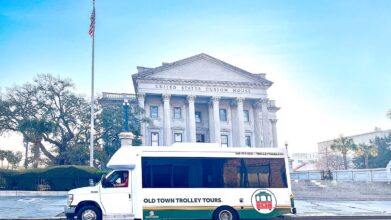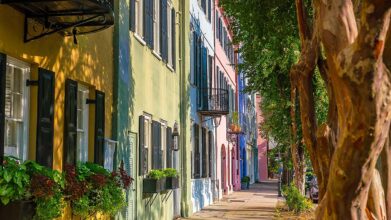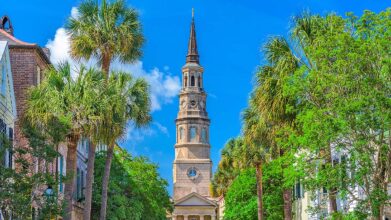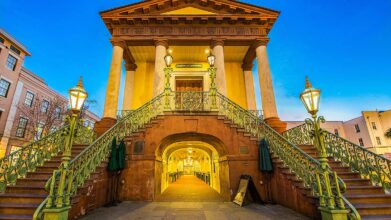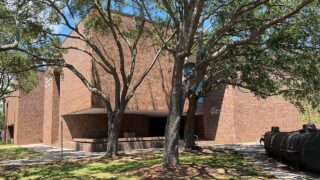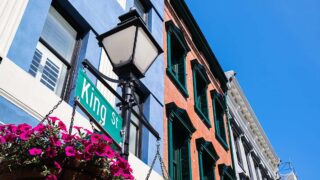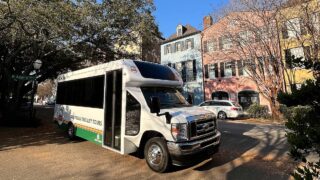Broad Street
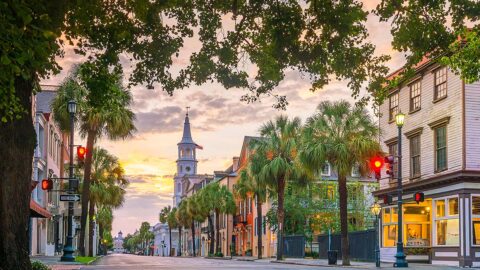
Broad Street runs through the heart of Charleston and offers a deep connection to the city’s past. Known as “Charleston’s Wall Street,” Broad Street has long been home to legal institutions, financial offices, and important civic buildings. Its historic homes, iconic landmarks, and preserved architecture make Broad Street a key part of the city’s historic district. A walk down Broad Street reveals centuries of stories, from Charleston’s earliest days to the present.
History of Broad Street
Broad Street’s story is deeply intertwined with the very foundation of Charleston. Originally laid out in the late 17th century as one of the primary axes of the Grand Modell plan for Charles Towne, it quickly became a vital artery for the burgeoning colony.
The Origins of Broad Street and Its Role in Charleston’s Early Development
Broad Street has played an essential role in Charleston’s growth since the city’s earliest days. First laid out in the late 1600s as part of the Grand Modell plan for Charles Towne, it served as one of the original streets designed to organize the settlement. Its location within the city’s fortified walls made it a key part of daily life, where residences, taverns and early businesses operated side by side. The street’s unusually wide design made it ideal for cart traffic, public gatherings, and civic development, helping establish its long-standing importance.
How Broad Street Became a Hub for Law, Finance and Commerce
As Charleston expanded into a thriving port city, Broad Street began to evolve into a place of influence and industry. Many of the earliest homes were replaced by formal banks, law offices and government buildings. By the 1800s, Broad Street had earned the nickname “Charleston’s Wall Street” for its concentration of legal and financial institutions. Much of the architecture from this period still stands today, showcasing styles like Georgian, Federal, and Greek Revival. Several of the businesses and firms that opened during this time are still operating, making Broad Street one of the most historically intact commercial districts in the South.
The Impact of the Civil War and Reconstruction on Broad Street
During the Civil War, Charleston endured blockades, fires, and hardship, but much of Broad Street’s core remained structurally intact. After the war, the city faced economic instability and political change, and Broad Street became a place of gradual rebuilding. Law firms and financial institutions adapted to the realities of Reconstruction and played a role in helping the city recover. The buildings from this period reflect that layered history. Behind their preserved facades are stories of adaptation, resilience and the complex legacy of the postwar South.
Preservation Efforts and Status as a Historic District Today
In the 20th century, preservationists recognized Broad Street as a vital part of Charleston’s identity. Efforts were made to restore original building details, protect interiors and maintain the historical layout of the street. Today, Broad Street is protected as part of the Charleston Historic District and remains one of the most carefully preserved areas in the city. Visitors walking along its sidewalks encounter more than beautiful architecture. They see evidence of every chapter of Charleston’s past, from its colonial beginnings to the civic and legal institutions that continue to define the street’s character.
Broad Street Fun Facts
- Broad Street is often called “Charleston’s Wall Street” because of its long history as the city’s center for law, finance and commerce. The nickname reflects the number of banks, government offices and legal institutions that have operated here for generations. Many of these establishments are still active today, continuing Broad Street’s legacy as a place of influence.
- Several law offices along Broad Street are among the oldest continuously operating firms in the United States. These historic practices date back to the early 1800s and have served Charleston’s residents through wars, political shifts, and economic change. Some still operate from the same buildings where they were originally founded.
- Broad Street is lined with well-preserved examples of Georgian, Federal, and Victorian architecture. Many of the buildings feature original brickwork, decorative cornices, and wrought-iron balconies that reflect Charleston’s rich design traditions. Walking the street feels like stepping through a living museum of architectural history.
- Hidden alleyways along Broad Street lead to quiet courtyards and historic gardens. These small passageways reveal another side of Charleston, where busy public spaces give way to peaceful retreats. Some of these courtyards date back centuries and offer a glimpse into the city’s more private residential life.
- The “Four Corners of Law” is one of Charleston’s most iconic intersections and is located on Broad Street. At this single crossing, visitors will find Charleston City Hall, the South Carolina Supreme Court, the United States Post Office and Courthouse, and St. Michael’s Church. Each corner represents a different pillar of authority — municipal, state, federal and religious.
Best Times To Visit Broad Street
Broad Street offers something special in every season, but spring and fall are often the most comfortable times to explore. The mild weather, blooming flowers and cool breezes make it ideal for walking and sightseeing. In the spring, the city comes alive with seasonal events and historic garden tours, while fall offers crisp air and colorful foliage. Summers can be warm and humid, especially in the afternoons, so it’s best to visit earlier in the day. Winter is quieter, with fewer tourists, giving visitors a peaceful way to enjoy Broad Street’s history and architecture without the crowds.
Parking Options and Accessibility Tips
Finding parking near Broad Street can take some patience, particularly during busy weekends or holidays. Metered street parking is available along parts of Broad Street and on nearby roads, but time limits are strictly enforced. Several parking garages are located close to the area, including those on Queen Street, Cumberland Street and near the Charleston City Market. Many of the sidewalks along Broad Street are wide and relatively flat, making the area accessible for most visitors. If you’re staying nearby or prefer not to drive, ride-share services are a convenient option with common drop-off points near the Four Corners of Law and St. Michael’s Church.
Walking or Guided Tours: What’s the Best Way To Explore?
There’s no wrong way to experience Broad Street, but how you explore can shape what you take away from the visit. A self-guided walk lets you move at your own pace, take photos and stop at anything that catches your eye. You’ll find historical markers and plaques that share bits of Charleston’s story along the way. For those who want a deeper understanding of the people, places and events that shaped the city, a guided tour can offer added insight. Tours offered by Old Town Trolley Tours® include expert narration, local knowledge and engaging stories that help bring Broad Street’s past to life. Both options offer a rewarding experience. It all depends on how much history you’d like to uncover during your visit.
Things To Do on Broad Street
Four Corners of Law
Located at the intersection of Broad and Meeting Streets, the Four Corners of Law is one of the most recognized sites in Charleston. Each corner represents a different authority: Charleston City Hall for municipal law, the South Carolina Supreme Court for state law, the United States Post Office and Courthouse for federal law, and St. Michael’s Church for religious law. This meeting point highlights Broad Street’s historic role in shaping the legal and civic life of the city.
Old Exchange and Provost Dungeon
Just steps from Broad Street, the Old Exchange and Provost Dungeon is one of Charleston’s most significant colonial-era buildings. Originally used as a commercial exchange, it later served as a prison during the Revolutionary War, where British forces held American patriots and other prisoners. Today, visitors can explore the main hall, once used for public meetings and receptions, and then descend into the underground dungeon to see the darker side of Charleston’s past.
St. Michael’s Church
Standing at the corner of Broad Street since the 1760s, St. Michael’s is Charleston’s oldest surviving religious structure. The church features classic Georgian architecture, a tall white steeple and original pews that have welcomed generations of worshippers. Outside, its historic graveyard includes notable names from American history. The church remains an active place of worship and a peaceful stop for those exploring the area.
Gibbes Museum of Art
Located near the Broad Street corridor, the Gibbes Museum showcases artwork from across the American South, with a strong focus on Charleston’s artistic legacy. Its permanent collection includes paintings, sculpture and decorative arts spanning colonial times to the present day. Temporary exhibitions bring in national and international works, and the museum’s historic Beaux-Arts building adds to its charm. It’s a meaningful stop for visitors interested in the city’s creative side.
Charleston City Hall
Facing Broad Street since the early 1800s, Charleston City Hall is both a functioning government building and a historic landmark. Originally constructed as a bank, it became the seat of city government in 1819. The building features a marble entrance, grand staircases and council chambers filled with period artwork and antique furnishings. Visitors are often welcome to step inside and view the preserved interiors, adding another layer to their understanding of Broad Street’s importance.
Washington Square Park
Tucked just behind Charleston City Hall on Broad Street, Washington Square Park offers a peaceful green space in the heart of downtown. Shaded by large oak trees and surrounded by historic buildings, the park features a statue of George Washington and several monuments dedicated to South Carolina history. It’s a quiet place to rest, read a plaque or simply enjoy the slower pace of the city. Many visitors pass through while exploring the civic landmarks nearby.
Postal Museum
Housed within the historic United States Post Office building at the Four Corners of Law, the Charleston Postal Museum offers a look into the city’s communication history. Located right on Broad Street, this small but engaging museum features original mailboxes, antique postal equipment and exhibits about how mail service shaped the development of Charleston. It’s a great hidden gem for those interested in local history and often overlooked by casual visitors.
Rainbow Row
Although Rainbow Row technically faces East Bay Street, its western end is just a short walk from Broad Street, making it a convenient stop for anyone in the area. These brightly painted 18th-century town homes are one of Charleston’s most photographed sites. The row was restored in the 1930s and has since become a symbol of the city’s dedication to preservation. While the homes are private residences, visitors are welcome to admire them from the sidewalk and capture a classic Charleston photo.
Dock Street Theatre
A short stroll from Broad Street, Dock Street Theatre is one of the oldest theaters in the United States. Originally opened in the 1730s and rebuilt in the 20th century, it continues to host performances ranging from classic plays to local productions. The building itself is a blend of restored history and modern comfort, with carved wood interiors and a grand stage. Even if you’re not seeing a show, the theater’s facade and entrance hall are worth a visit for their beauty and craftsmanship.
Nearby Things To Do
Old Town Trolley Tours
Experiencing Broad Street from the vantage point of the Old Town Trolley Tours provides a captivating look into Charleston’s heart, where history and modern life intertwine. As the trolley journeys along Broad Street, the fully narrated tour highlights the significance of the architectural gems that line this important thoroughfare and its pivotal role in Charleston’s story. From this comfortable vantage point, you can appreciate the historical context of the buildings and the street itself, gaining insights into Charleston’s unique character and enduring past without the hassle of navigating on foot or worrying about parking.
Walk Along The Battery
Just a short walk south of Broad Street, The Battery offers sweeping views of Charleston Harbor, Fort Sumter and Castle Pinckney. This historic waterfront promenade is lined with grand antebellum homes and shaded walkways that make it ideal for a scenic stroll. Visitors can relax in White Point Garden or take in the peaceful atmosphere while reflecting on the city’s maritime and military history.
Explore King Street’s Shopping and Dining Scene
Running parallel to Broad Street, King Street is one of Charleston’s most well-known destinations for shopping, dining and entertainment. The area is home to a mix of local boutiques, national retailers, antique shops and art galleries. Restaurants and cafes line the sidewalks, offering everything from casual bites to fine dining. It’s the perfect spot to extend your day after exploring the historic district.
Visit Waterfront Park and the Pineapple Fountain
Waterfront Park is located along the Cooper River and is only a few blocks from the eastern end of Broad Street. Known for its shaded paths, riverfront views and iconic Pineapple Fountain, the park is a favorite for both locals and visitors. Benches, swings and breezy walking trails make it a great place to pause and enjoy the harbor breeze. It’s also one of the city’s most photographed spots.
Tour the Nathaniel Russell House
Located just off Broad Street, the Nathaniel Russell House is a beautifully restored Federal-style mansion and a National Historic Landmark. Built in 1808, the home features a stunning three-story spiral staircase and period furnishings that reflect the life of a wealthy Charleston merchant. Guided tours provide insight into both the architecture and the people who lived there.
Experience the South Carolina Aquarium
Positioned along the Charleston Harbor, the South Carolina Aquarium is a short drive or extended walk from Broad Street. The aquarium showcases marine life native to South Carolina and offers interactive exhibits, touch tanks, and a two-story Great Ocean Tank filled with sea turtles and colorful fish. It’s a great stop for families or anyone interested in the region’s natural environment.
Wander Through the French Quarter District
Adjacent to Broad Street, the French Quarter is one of Charleston’s oldest neighborhoods. The area is filled with cobblestone streets, historic churches and early colonial buildings that now house art galleries, studios, and cafes. It’s a quieter, more tucked-away part of the city that’s ideal for wandering and discovering hidden courtyards and local artwork.
Conclusion
Broad Street continues to play a defining role in Charleston’s story. From its origins as a colonial thoroughfare to its rise as the city’s legal and financial center, Broad Street reflects the larger evolution of Charleston itself. Walking along this historic street, visitors encounter preserved architecture, civic landmarks, and institutions that have shaped the city for generations. It offers more than a look at the past. It gives you a sense of how Charleston has grown while remaining deeply connected to its roots.
Because of its location in the heart of downtown, Broad Street is also an ideal starting point for exploring nearby attractions. The Battery, Rainbow Row and King Street are all within easy walking distance, offering scenic views, colorful homes, and places to shop, dine and relax. Along the way, you’ll discover hidden courtyards, small museums, and quiet spaces that invite you to slow down and take in the city’s rhythm.
This part of Charleston offers something for every visitor. Those who enjoy history, architecture or simply experiencing the city’s culture at a slower pace will find that Broad Street offers something meaningful at every turn.
FAQs
What is Broad Street famous for?
Broad Street is known as Charleston’s legal, financial and civic center. It has earned the nickname “Charleston’s Wall Street” due to the concentration of banks, courthouses, law offices and government buildings that have operated here for centuries. In addition to its civic importance, Broad Street is also famous for its architectural beauty, walkability and connection to several of Charleston’s most historic sites.
What are three interesting facts about Broad Street?
Broad Street is full of unique details that make it one of Charleston’s most visited streets. It is home to the Four Corners of Law, where four buildings represent city, state, federal and religious authority at a single intersection. Many of the law offices along Broad Street are among the oldest in the country and still operate out of their original buildings. The street also features several hidden alleyways that lead to private gardens and courtyards, a reminder of Charleston’s layered layout and colonial roots.
What are some must-see attractions on Broad Street?
Some of the most important landmarks in Charleston are located along Broad Street. Highlights include the Old Exchange and Provost Dungeon, St. Michael’s Church, Charleston City Hall, the South Carolina Supreme Court and Washington Square Park. Nearby, visitors can explore the Gibbes Museum of Art, Rainbow Row, and the historic Dock Street Theatre. These sites reflect Charleston’s legal, cultural and architectural history.
Are there any haunted locations on Broad Street?
Yes, several locations on and near Broad Street are tied to Charleston’s long history of ghost stories and unexplained events. The Old Exchange and Provost Dungeon is often cited as one of the most haunted buildings in the city, with its history as a Revolutionary War prison adding to its eerie atmosphere. Some local walking tours include Broad Street as part of their ghost routes, pointing out buildings where strange noises, cold spots or flickering lights have been reported over the years.
How long does it take to walk Broad Street?
Walking the main stretch of Broad Street through the historic district can take anywhere from 20 to 30 minutes, depending on your pace. However, most visitors spend longer exploring the various attractions and reading the historic markers posted along the way. With nearby parks, museums, churches and civic buildings, a full visit can easily fill an hour or more. Many guided tours include Broad Street as a featured portion of their route.
What is the best way to experience Broad Street for first-time visitors?
First-time visitors can explore Broad Street on foot to take in the historic architecture and visit key landmarks up close. For those interested in deeper context, guided tours such as those offered by Old Town Trolley Tours® are a great option. These tours provide live narration, insider stories and convenient access to nearby attractions. Stopping by during the morning or late afternoon offers the best lighting for photos and a more relaxed atmosphere.

